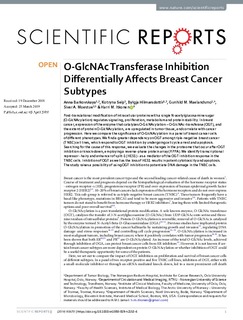| dc.contributor.author | Barkovskaya, Anna | |
| dc.contributor.author | Seip, Kotryna | |
| dc.contributor.author | Hilmarsdòttir, Bylgja | |
| dc.contributor.author | Mælandsmo, Gunhild Mari | |
| dc.contributor.author | Moestue, Siver Andreas | |
| dc.contributor.author | Itkonen, Harri | |
| dc.date.accessioned | 2019-04-25T07:27:52Z | |
| dc.date.available | 2019-04-25T07:27:52Z | |
| dc.date.created | 2019-03-28T09:31:48Z | |
| dc.date.issued | 2019 | |
| dc.identifier.issn | 2045-2322 | |
| dc.identifier.uri | http://hdl.handle.net/11250/2595358 | |
| dc.description.abstract | Post-translational modification of intracellular proteins with a single N-acetylglucosamine sugar (O-GlcNAcylation) regulates signaling, proliferation, metabolism and protein stability. In breast cancer, expression of the enzyme that catalyzes O-GlcNAcylation – O-GlcNAc-transferase (OGT), and the extent of protein O-GlcNAcylation, are upregulated in tumor tissue, and correlate with cancer progression. Here we compare the significance of O-GlcNAcylation in a panel of breast cancer cells of different phenotypes. We find a greater dependency on OGT among triple-negative breast cancer (TNBC) cell lines, which respond to OGT inhibition by undergoing cell cycle arrest and apoptosis. Searching for the cause of this response, we evaluate the changes in the proteome that occur after OGT inhibition or knock-down, employing a reverse-phase protein array (RPPA). We identify transcriptional repressor - hairy and enhancer of split-1 (HES1) - as a mediator of the OGT inhibition response in the TNBC cells. Inhibition of OGT as well as the loss of HES1 results in potent cytotoxicity and apoptosis. The study raises a possibility of using OGT inhibition to potentiate DNA damage in the TNBC cells. | nb_NO |
| dc.language.iso | eng | nb_NO |
| dc.publisher | Nature Research | nb_NO |
| dc.rights | Navngivelse 4.0 Internasjonal | * |
| dc.rights.uri | http://creativecommons.org/licenses/by/4.0/deed.no | * |
| dc.title | O-GlcNAc Transferase Inhibition Differentially Affects Breast Cancer Subtypes | nb_NO |
| dc.type | Journal article | nb_NO |
| dc.type | Peer reviewed | nb_NO |
| dc.description.version | publishedVersion | nb_NO |
| dc.source.volume | 9 | nb_NO |
| dc.source.journal | Scientific Reports | nb_NO |
| dc.source.issue | 1 | nb_NO |
| dc.identifier.doi | 10.1038/s41598-019-42153-6 | |
| dc.identifier.cristin | 1688438 | |
| dc.relation.project | Kreftforeningen: 90393200 | nb_NO |
| dc.relation.project | Norges forskningsråd: 239940 | nb_NO |
| dc.description.localcode | Open Access This article is licensed under a Creative Commons Attribution 4.0 International License, which permits use, sharing, adaptation, distribution and reproduction in any medium or format, as long as you give appropriate credit to the original author(s) and the source, provide a link to the Creative Commons license, and indicate if changes were made. | nb_NO |
| cristin.unitcode | 194,65,25,0 | |
| cristin.unitcode | 194,65,15,0 | |
| cristin.unitname | Institutt for sirkulasjon og bildediagnostikk | |
| cristin.unitname | Institutt for klinisk og molekylær medisin | |
| cristin.ispublished | false | |
| cristin.fulltext | original | |
| cristin.qualitycode | 1 | |

